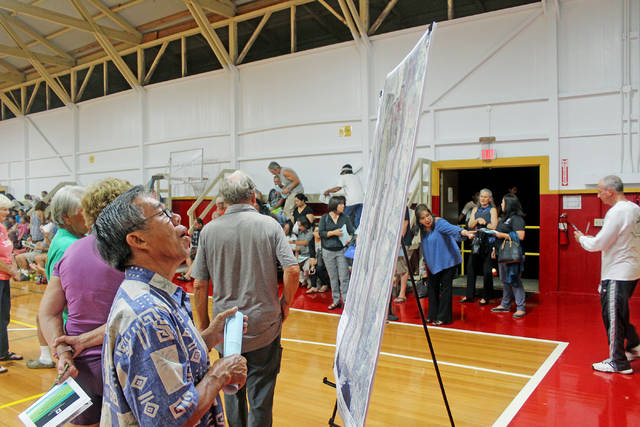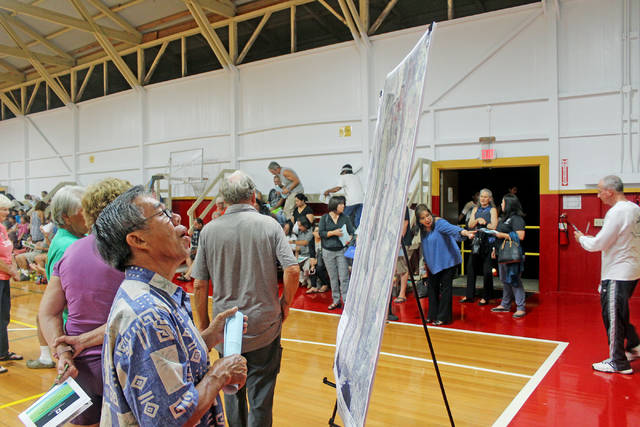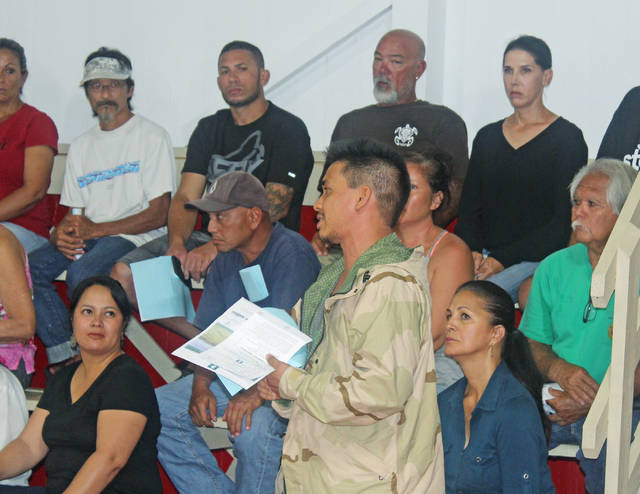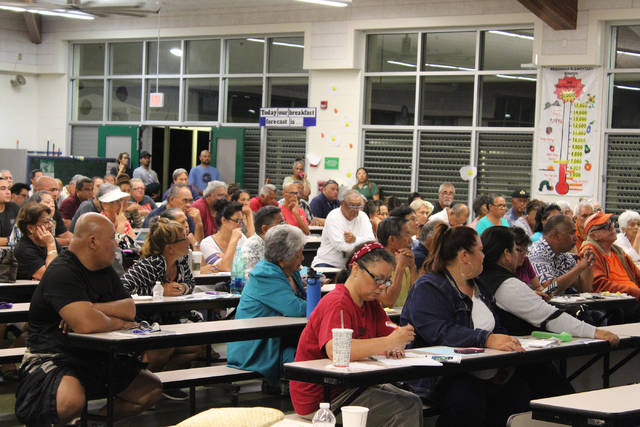DHHL ag leases could be ready by late 2018
The Department of Hawaiian Home Lands wants future landholders and Honomu community members to help plan their new subsistence agriculture development.
ADVERTISING
“People aren’t used to coming in so early in the process,” said Julie Cachola, senior DHHL planner.
Cachola and DHHL staff aren’t imposing their own ideas. Rather, they’re getting input from affected people — and incorporating that input into a “conceptual plan.”
Once that’s done, DHHL will present it publicly in January 2018, seeking constructive criticism before revising it during 2018 to make a master plan.
The Hawaiian Homes Commission Act, passed by Congress in 1920 and signed into law by President Warren G. Harding in 1921, “provides for the rehabilitation of the Native Hawaiian people through a government-sponsored homesteading program,” DHHL says online.
To qualify for a lease, a person must have at least 50 percent Hawaiian blood — a concept known as 50 percent “blood quantum.”
Beneficiaries granted a lease pay $1 rent annually for a 99-year lease, extendable up to an additional 100 years. Succeeding generations can inherit a lease, but only if blood quantum remains above 25 percent.
Leases statewide can be for residential, agricultural, aquacultural or pastoral use.
DHHL sent invitations to the top 500 people on its agriculture waiting list (which is longer on every island, except Oahu, than the residential waiting list) for a Tuesday night beneficiaries meeting at Keaukaha Elementary School.
About 200 attended, filling the cafeteria with people from infancy to elderly.
Cachola said DHHL wants a “pool” of potential lessees big enough to draw from.
Some, she said, won’t be interested. Others might not be able for a variety of reasons, such as age, health or career. The average age of invitees was 66, and they had first applied for home lands between 1952 and 1985.
They were invited to consider 766 acres of Hawaiian home lands surrounding both sides of Akaka Falls Drive.
It remains unclear how many leases will be awarded because some of the land isn’t arable and some is flood-prone. Some beneficiaries might want 1 acre, others 3. A study of how much land is actually arable is underway.
A DHHL subsistence agriculture lease will include a maximum of 3 acres of land. Leaseholders must cultivate that land within three years.
Sherri Hiraoka, principal planner with Townscape, a Hawaii environmental and community planning company working with DHHL, said development of criteria for how to document that a leaseholder is actually cultivating land is still “in process.”
Agricultural lots offered previously required a farm plan. But subsistence agriculture lots don’t. Building a home is optional.
“Will we be able to raise our own chickens and cows and pigs?” on a subsistence agriculture plot, asked audience member Noe Pualoa of Kailua-Kona.
Agricultural lots in the past allowed growth of either crops or livestock — but not both.
“The subsistence allows you to do both,” Cachola answered.
Two people in different areas of the room let out an audible, “Wow!”
DHHL told residents they’ll need to address odor, waste and noise and take neighbors into consideration.
Later, Pualoa said she’s interested in moving to the Honomu area.
“But I need to grow my pigs, my chickens and my cows,” she said, giving a thumbs-up to Cachola’s answer.
During a community meeting Monday night with DHHL at the Honomu Gym, attended by more than 150 people, Ala Savio said he owns land just makai of the DHHL tracts at Honomu.
He asked how DHHL will make sure insecticides, herbicides and animal waste from land closer to Akaka Falls do not negatively affect the environment all along the way and into the ocean.
He suggested that environmental, waste and water management be part of the master plan.
“I just really kind of ‘plead’ to you, almost, to do it right,” he said to applause.
“Do it right. Do it good. We have to try to keep good water.”
Cachola said DHHL wants to offer coaching, education and facilities to help leaseholders succeed and is taking suggestions such as Savio’s into account while developing the plan.
For example, a community center could be a facility for leaseholders and others in Honomu to connect. Such a facility, she said, will work better if it exists before leases get offered.
With subsistence agriculture, she said, a family might sell some produce at farmers markets once in a while because “we all need a little cash.” But subsistence agriculture is not intended to create an income-producing family farm.
It means growing foods to sustain self, family, extended family and the surrounding community, Cachola said.
Those who want to develop income-producing family farms, with crops to sell, might get to do so, but not during initial development.
At the Honomu Gym Monday night, community members welcomed homesteaders with open arms and expressed a desire to be friends and neighbors.
But some also complained that Hawaiians get to homestead without having to buy.
DHHL representatives pointed in response to the Hawaii Admissions Act, which requires Hawaii — and its people — to accept in perpetuity the Hawaiian Homes Commission Act as part of its constitution in order for Hawaii to become the 50th state.
Jobie Masagatani, chair of the Hawaiian Homes Commission, told Honomu Gym attendees that Congress in 1920 wanted to reconnect the Hawaiian people with their land for economic well being, self sufficiency and “recovery of a population.”
Home lands in Honomu “is going to be your legacy place. Sleep on it. Talk about it. Have some ideas,” Cachola told potential leaseholders.
Patrick Kahawaiolaa, president of the Keaukaha Community Association, sought clarification at the Keaukaha meeting.
“We need administrative rules,” he said. Only one house is allowed per lease. But could someone also build a tool shed, a tractor shed and a barn for cows?
Another audience member asked if a family of five wants a lease, how many acres are needed to grow enough kalo to eat three meals a day?
DHHL has not provided answers to that yet. But planners will use such input to make it easier for leaseholders to succeed.
Environmental studies are currently underway, as is a cultural assessment. Power lines along Akaka Falls Road illustrate that some basic infrastructure is already in place. Wastewater systems and water catchment will be needed, Cachola said.
Currently, there are 10,000 leaseholders statewide, she said, and 44,000 Native Hawaiians on the waiting list for home lands.
DHHL will hold meetings over the course of the coming year, with hopes for the first Honomu leases to be granted in December 2018.
“Is that possible? One year to do this? That’s unheard of,” Cachola said to potential beneficiaries. “But, let’s try.”
Email Jeff Hansel at jhansel@hawaiitribune-herald.com.

Featured Jobs
Featured JobsDHHL ag leases could be ready by late 2018



The Department of Hawaiian Home Lands wants future landholders and Honomu community members to help plan their new subsistence agriculture development.
The Department of Hawaiian Home Lands wants future landholders and Honomu community members to help plan their new subsistence agriculture development.
“People aren’t used to coming in so early in the process,” said Julie Cachola, senior DHHL planner.
ADVERTISING
Cachola and DHHL staff aren’t imposing their own ideas. Rather, they’re getting input from affected people — and incorporating that input into a “conceptual plan.”
Once that’s done, DHHL will present it publicly in January 2018, seeking constructive criticism before revising it during 2018 to make a master plan.
The Hawaiian Homes Commission Act, passed by Congress in 1920 and signed into law by President Warren G. Harding in 1921, “provides for the rehabilitation of the Native Hawaiian people through a government-sponsored homesteading program,” DHHL says online.
To qualify for a lease, a person must have at least 50 percent Hawaiian blood — a concept known as 50 percent “blood quantum.”
Beneficiaries granted a lease pay $1 rent annually for a 99-year lease, extendable up to an additional 100 years. Succeeding generations can inherit a lease, but only if blood quantum remains above 25 percent.
Leases statewide can be for residential, agricultural, aquacultural or pastoral use.
DHHL sent invitations to the top 500 people on its agriculture waiting list (which is longer on every island, except Oahu, than the residential waiting list) for a Tuesday night beneficiaries meeting at Keaukaha Elementary School.
About 200 attended, filling the cafeteria with people from infancy to elderly.
Cachola said DHHL wants a “pool” of potential lessees big enough to draw from.
Some, she said, won’t be interested. Others might not be able for a variety of reasons, such as age, health or career. The average age of invitees was 66, and they had first applied for home lands between 1952 and 1985.
They were invited to consider 766 acres of Hawaiian home lands surrounding both sides of Akaka Falls Drive.
It remains unclear how many leases will be awarded because some of the land isn’t arable and some is flood-prone. Some beneficiaries might want 1 acre, others 3. A study of how much land is actually arable is underway.
A DHHL subsistence agriculture lease will include a maximum of 3 acres of land. Leaseholders must cultivate that land within three years.
Sherri Hiraoka, principal planner with Townscape, a Hawaii environmental and community planning company working with DHHL, said development of criteria for how to document that a leaseholder is actually cultivating land is still “in process.”
Agricultural lots offered previously required a farm plan. But subsistence agriculture lots don’t. Building a home is optional.
“Will we be able to raise our own chickens and cows and pigs?” on a subsistence agriculture plot, asked audience member Noe Pualoa of Kailua-Kona.
Agricultural lots in the past allowed growth of either crops or livestock — but not both.
“The subsistence allows you to do both,” Cachola answered.
Two people in different areas of the room let out an audible, “Wow!”
DHHL told residents they’ll need to address odor, waste and noise and take neighbors into consideration.
Later, Pualoa said she’s interested in moving to the Honomu area.
“But I need to grow my pigs, my chickens and my cows,” she said, giving a thumbs-up to Cachola’s answer.
During a community meeting Monday night with DHHL at the Honomu Gym, attended by more than 150 people, Ala Savio said he owns land just makai of the DHHL tracts at Honomu.
He asked how DHHL will make sure insecticides, herbicides and animal waste from land closer to Akaka Falls do not negatively affect the environment all along the way and into the ocean.
He suggested that environmental, waste and water management be part of the master plan.
“I just really kind of ‘plead’ to you, almost, to do it right,” he said to applause.
“Do it right. Do it good. We have to try to keep good water.”
Cachola said DHHL wants to offer coaching, education and facilities to help leaseholders succeed and is taking suggestions such as Savio’s into account while developing the plan.
For example, a community center could be a facility for leaseholders and others in Honomu to connect. Such a facility, she said, will work better if it exists before leases get offered.
With subsistence agriculture, she said, a family might sell some produce at farmers markets once in a while because “we all need a little cash.” But subsistence agriculture is not intended to create an income-producing family farm.
It means growing foods to sustain self, family, extended family and the surrounding community, Cachola said.
Those who want to develop income-producing family farms, with crops to sell, might get to do so, but not during initial development.
At the Honomu Gym Monday night, community members welcomed homesteaders with open arms and expressed a desire to be friends and neighbors.
But some also complained that Hawaiians get to homestead without having to buy.
DHHL representatives pointed in response to the Hawaii Admissions Act, which requires Hawaii — and its people — to accept in perpetuity the Hawaiian Homes Commission Act as part of its constitution in order for Hawaii to become the 50th state.
Jobie Masagatani, chair of the Hawaiian Homes Commission, told Honomu Gym attendees that Congress in 1920 wanted to reconnect the Hawaiian people with their land for economic well being, self sufficiency and “recovery of a population.”
Home lands in Honomu “is going to be your legacy place. Sleep on it. Talk about it. Have some ideas,” Cachola told potential leaseholders.
Patrick Kahawaiolaa, president of the Keaukaha Community Association, sought clarification at the Keaukaha meeting.
“We need administrative rules,” he said. Only one house is allowed per lease. But could someone also build a tool shed, a tractor shed and a barn for cows?
Another audience member asked if a family of five wants a lease, how many acres are needed to grow enough kalo to eat three meals a day?
DHHL has not provided answers to that yet. But planners will use such input to make it easier for leaseholders to succeed.
Environmental studies are currently underway, as is a cultural assessment. Power lines along Akaka Falls Road illustrate that some basic infrastructure is already in place. Wastewater systems and water catchment will be needed, Cachola said.
Currently, there are 10,000 leaseholders statewide, she said, and 44,000 Native Hawaiians on the waiting list for home lands.
DHHL will hold meetings over the course of the coming year, with hopes for the first Honomu leases to be granted in December 2018.
“Is that possible? One year to do this? That’s unheard of,” Cachola said to potential beneficiaries. “But, let’s try.”
Email Jeff Hansel at jhansel@hawaiitribune-herald.com.





